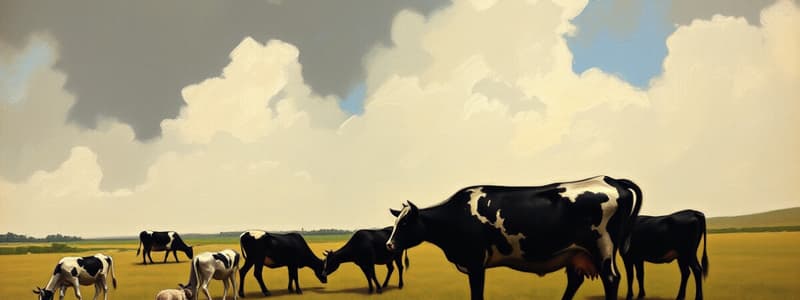Podcast
Questions and Answers
Who does Mr. Jones represent in Animal Farm?
Who does Mr. Jones represent in Animal Farm?
- Lenin
- Stalin
- Trotsky
- Czar Nicholas II (correct)
Who is Mrs. Jones?
Who is Mrs. Jones?
Czar's wife, Alexandra
What does Old Major represent?
What does Old Major represent?
- Lenin/Karl Marx (correct)
- Snowball
- Napoleon
- Czar Nicholas II
What is Snowball known for?
What is Snowball known for?
Who does Napoleon represent in Animal Farm?
Who does Napoleon represent in Animal Farm?
What role does Squealer play in Animal Farm?
What role does Squealer play in Animal Farm?
Boxer represents the _____ class.
Boxer represents the _____ class.
What do the dogs represent?
What do the dogs represent?
What does Moses the raven symbolize?
What does Moses the raven symbolize?
Who does Mollie represent?
Who does Mollie represent?
What do the hens represent?
What do the hens represent?
What do the sheep's chants represent?
What do the sheep's chants represent?
Match the following farms to their representations:
Match the following farms to their representations:
Sugar Candy Mountain represents _____ in Animal Farm.
Sugar Candy Mountain represents _____ in Animal Farm.
Flashcards are hidden until you start studying
Study Notes
Key Characters and Their Symbolism
- Mr. Jones: Represents Czar Nicholas II; depicts the irresponsible and abusive ruling class who neglects and mistreats the working population.
- Mrs. Jones: Symbolizes Alexandra, the wife of the Czar, indicating the close ties and shared culpabilities of the ruling elite.
- Old Major: Embodies Lenin/Karl Marx, advocating for animal rebellion against human oppression; introduces the philosophy of Animalism and inspires the revolution through the song "Beasts of England".
Revolutionary Leaders
- Snowball: Reflects Leon Trotsky's contributions; a key figure in the rebellion, later scapegoated and exiled by Napoleon's authoritarian regime.
- Napoleon: Represents Joseph Stalin; consolidates power post-rebellion, becoming a tyrannical leader who eliminates dissent and enforces control through fear.
Propaganda and Control
- Squealer: Epitomizes Russian media and propaganda; manipulates language to control perceptions and reinforce the authority of Napoleon.
- Dogs (Bluebell, Jessie, Pincher): Symbolize Stalin's KGB, using intimidation to maintain power and eliminate opposition, showcasing the oppressive means of governance.
The Working Class
- Boxer: Represents the dedicated working class, showcasing loyalty and hard work, ultimately betrayed by the regime when sold for profit.
- Clover: Boxer's female counterpart, sharing his ideals and perseverance, symbolizing the struggles of female workers.
Religion and Ideology
- Moses: Represents the Russian Orthodox Church, using tales of Sugarcandy Mountain to pacify the workers and discourage rebellion.
Social Classes and Reactions
- Mollie: Symbolizes the self-indulgent upper class; her refusal to engage in the revolution highlights the ignorance of those who benefited from the existing system.
- Muriel: Represents the educated but disillusioned observers who witness the decline of revolutionary ideals.
- Old Benjamin: The cynical donkey reflects skepticism among the masses about the effectiveness of the revolution; loyal to Boxer despite his doubts.
Social Structure
- Hens: Symbolize peasant farmers resisting authority, illustrating the conflict within social classes.
- Rats and Rabbits: Depict marginalized groups seen as undesirables in society, akin to the perception of gypsies and thieves.
- Pigeons: Represent the spread of revolutionary ideas beyond borders, embodying the global communist movement.
The Masses
- Sheep: Stand for the unthinking masses; their repetitive slogans illustrate the blind following of ideologies without critical thought.
Geography and Political Representation
- Farmer Pilkington: Represents England; politically opportunistic, willing to ally with the new regime for profit.
- Farmer Frederick: Symbolizes Adolf Hitler; an adversary that poses a threat to the farm's stability.
- Manor Farm: Represents old Russia, before the revolution, depicting historical injustices.
- Animal Farm: Symbolizes the new USSR; initially a hopeful vision distorted by betrayal and tyranny.
- Foxwood Farm: Represents England's rural land and its interactions with revolutionary ideologies.
- Pinchfield Farm: Symbolizes Germany, depicting its role in geopolitical tensions during the era.
- Farmhouse: Represents the Kremlin, signifying the heart of political power in the USSR.
Ideological Concepts
- Sugar Candy Mountain: Symbolizes heaven and the false promises of religion in providing comfort to the oppressed.
Studying That Suits You
Use AI to generate personalized quizzes and flashcards to suit your learning preferences.




